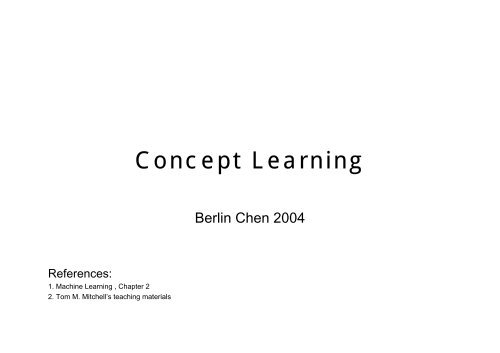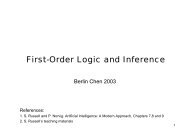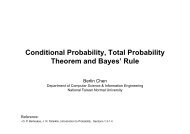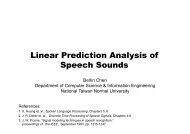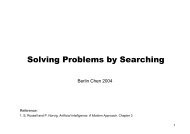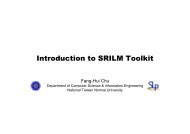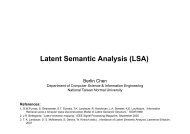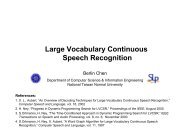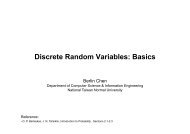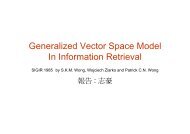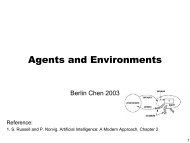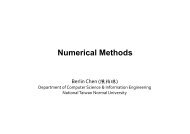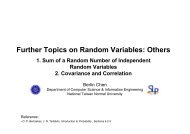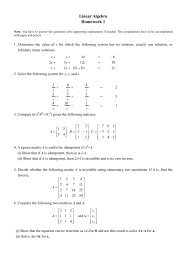Concept Learning (ML Ch. 2) - Berlin Chen
Concept Learning (ML Ch. 2) - Berlin Chen
Concept Learning (ML Ch. 2) - Berlin Chen
You also want an ePaper? Increase the reach of your titles
YUMPU automatically turns print PDFs into web optimized ePapers that Google loves.
<strong>Concept</strong> <strong>Learning</strong><br />
<strong>Berlin</strong> <strong>Ch</strong>en 2004<br />
References:<br />
1. Machine <strong>Learning</strong> , <strong>Ch</strong>apter 2<br />
2. Tom M. Mitchell’s teaching materials
What is a <strong>Concept</strong> ?<br />
<strong>Concept</strong> of<br />
Dogs<br />
<strong>Concept</strong> of<br />
Cats<br />
<strong>Concept</strong> of<br />
Horses<br />
<strong>Concept</strong> of<br />
Birds<br />
<strong>Concept</strong> of<br />
Fishes<br />
A concept describes a subset of<br />
objects or events defined over a<br />
larger set<br />
2
<strong>Concept</strong> <strong>Learning</strong><br />
learning based on symbolic representations<br />
• Acquire/Infer the definition of a general concept or<br />
category given a (labeled) sample of positive and<br />
negative training examples of the category<br />
– Each concept can be thought of as a Boolean-valued function<br />
• Approximate a Boolean-valued function from examples<br />
– <strong>Concept</strong> learning can be formulated as a problem of searching<br />
through a predefined space of potential hypotheses for the<br />
hypothesis that best fits the training examples<br />
– Take advantage of a naturally occurring structure over the<br />
hypothesis space<br />
• General-to-specific ordering of hypotheses<br />
3
Training Examples for EnjoySport<br />
• <strong>Concept</strong> to be learned<br />
– “Days on which Aldo enjoys his favorite water sport”<br />
Attributes<br />
Days<br />
• Days (examples/instances) are represented by a set of<br />
attributes<br />
• What is the general concept ?<br />
– The task is to learn to predict the value of EnjoySport for an<br />
arbitrary day based on the values of other attributes<br />
– Learn a (a set of) hypothesis representation(s) for the concept<br />
4
Representing Hypotheses<br />
• Many possible representations for hypotheses h<br />
• Here h is conjunction of constraints on attributes<br />
• Each constraint can be<br />
– A specific value (e.g., “Water=Warm” )<br />
– Don’t care (e.g., “Water=?” )<br />
A hypothesis is<br />
– No value acceptable (e.g., “Water=Ø ”)<br />
a vector of constraints<br />
• For example<br />
Sky AirTemp Humid Wind Water Forecast<br />
< Sunny ? ? Strong ? Same ><br />
– Most general hypothesis<br />
< ? ? ? ? ? ? ><br />
– Most specific hypothesis<br />
< Ø Ø Ø Ø Ø Ø ><br />
All are positive<br />
examples<br />
All are negative<br />
examples 5
Definition of <strong>Concept</strong> <strong>Learning</strong> Task<br />
• Given<br />
– Instances X: possible days, each described by the attributes<br />
Sky, AirTemp, Humidity, Wind, Water, Forecast<br />
(Sunny, Cloudy, Rainy) (Warm, Cold) (Normal, High) (Strong, Week) (Warm, Cool) (Same, <strong>Ch</strong>ange)<br />
– Target concept/function c : EnjoySport X → {0, 1}<br />
– Hypotheses H : Conjunctions of Literals. E.g.,<br />
– Training examples D : Positive and negative examples<br />
(members/nonmembers) of the target function<br />
, ,…., <br />
• Determine<br />
The Inductive <strong>Learning</strong> Hypothesis<br />
• Any hypothesis found to approximate the target function<br />
well over a sufficiently large set of training examples<br />
will also approximate the target function well over<br />
other unobserved examples<br />
– Assumption of Inductive <strong>Learning</strong><br />
• The best hypothesis regarding the unseen instances is the<br />
hypothesis that best fits the observed training data<br />
7
Viewing <strong>Learning</strong> As a Search Problem<br />
• <strong>Concept</strong> learning can be viewed as the task of searching<br />
through a large space of hypotheses<br />
Instance space X<br />
Sky (Sunny/Cloudy/Rainy)<br />
AirTemp (Warm/Cold)<br />
Humidity (Normal/High)<br />
Wind (Strong/Weak)<br />
Water (Warm/Cool)<br />
Forecast (Same/<strong>Ch</strong>ange)<br />
=> 3*2*2*2*2*2=96 instances<br />
Hypothesis space H<br />
5*4*4*4*4*4=5120 syntactically<br />
distinct hypotheses<br />
1+4*3*3*3*3*3=973 semantically<br />
distinct hypotheses<br />
Each hypothesis is represented as<br />
a conjunction of constraints<br />
Ø<br />
8
Viewing <strong>Learning</strong> As a Search Problem<br />
• Study of learning algorithms that examine different<br />
strategies for searching the hypothesis space<br />
• How to exploit the naturally occurring structure in the<br />
hypothesis apace ?<br />
– Relations among hypotheses<br />
9
General-to-Specific-Ordering of Hypothesis<br />
• Many concept learning algorithms organize the search<br />
through the hypothesis space by taking advantage of a<br />
naturally occurring structure over it<br />
– “general-to-specific ordering”<br />
Suppose that h 1<br />
and h 2<br />
classify<br />
positive examples<br />
• h 2 is more general than h 1<br />
– h 2 imposes fewer constraints on instances<br />
– h 2 classify more positive instances than h 1 does<br />
– A useful structure over the hypothesis space<br />
10
More-General-Than Partial Ordering<br />
• Definition<br />
– Let h j and h k be Boolean-valued functions defined over X.<br />
Then h j is more general than h k (h j > g h k ) if and only if<br />
( ∀x<br />
∈ X ) [( hk<br />
( x)<br />
= 1 ) → ( h j ( x)<br />
= 1)<br />
]<br />
x satisfies h k<br />
• We also can define the more-specific-than ordering<br />
11
General-to-Specific Ordering of Hypotheses<br />
• An illustrative example<br />
• Suppose instances are classified positive by h 1 , h 2 , h 3<br />
– h 2 (imposing fewer constraints) are more general than h 1 and h 3<br />
– h 1 ← ⎯→<br />
? h 3<br />
partial order relation<br />
- antisymmetric, transitive<br />
12
Find-S Algorithm<br />
• Find a maximally specific hypothesis by using the<br />
more-general-than partial ordering to organize the<br />
search for a hypothesis consistent with the observed<br />
training examples<br />
1. Initialize h to the most specific hypothesis in H<br />
2. For each positive training instance x<br />
– For each attribute constraint a i in h<br />
If the constraint a i in h is satisfied by x<br />
Then do nothing<br />
Else replace a i in h by the next more general constraint that is<br />
satisfied by x<br />
3. Output hypothesis h<br />
h ←<br />
φ , φ , φ , φ , φ , φ<br />
13
Find-S Algorithm<br />
• Hypothesis Space Search by Find-S<br />
no change!<br />
– Substitute a “?” in place of any attribute value in h that is not<br />
satisfied by the new example<br />
14
Find-S Algorithm<br />
• Why F-S never check a negative example ?<br />
– The hypothesis h found by it is the most specific one in H<br />
– Assume the target concept c is also in H which will cover both<br />
the training and unseen positive examples<br />
• c is more general than h<br />
– Because the target concept will not cover the negative examples,<br />
thus neither will the hypothesis h<br />
15
Complaints about Find-S<br />
• Can not tell whether it has learned concept<br />
(Output only one. Many other consistent hypotheses may exist!)<br />
• Picks a maximally specific h (why?)<br />
(Find a most specific hypothesis consistent with the training data)<br />
• Can not tell when training data inconsistent<br />
– What if there are noises or errors contained in training examples<br />
• Depending on H, there might be several !<br />
16
Consistence of Hypotheses<br />
• A hypothesis h is consistent with a set of training<br />
examples D of target concept c if and only if<br />
h(x)=c(x) for each training example in D<br />
( h, D) ≡ ∀ x,<br />
c( x)<br />
( ∈ D) h( x) c( x)<br />
Consistent =<br />
• But satisfaction has another meaning<br />
– An example x is said to satisfy a hypothesis h when h(x)=1,<br />
regardless of whether x is positive or negative example of the<br />
target concept<br />
17
Version Space<br />
Mitchell 1977<br />
• The version space VS H,D with respect to hypothesis<br />
space H and training examples D is the subset of<br />
hypotheses from H consistent with all training<br />
examples in D<br />
VS<br />
H<br />
, D ≡ ∈<br />
( h,<br />
D )<br />
{ h H Consistent }<br />
– A subspace of hypotheses<br />
– Contain all plausible versions ( 描 述 ) of the target concepts<br />
18
List-Then-Eliminate Algorithm<br />
1. VersionSpace ← a list containing all hypotheses in H<br />
2. For each training example, <br />
remove from VersionSpace any hypothesis h for which<br />
h(x)≠c(x)<br />
– i.e., eliminate hypotheses inconsistent with any training<br />
examples<br />
– The VersionSpace shrinks as more examples are observed<br />
3. Output the list of hypotheses in VersionSpace<br />
19
Drawbacks of List-Then-Eliminate<br />
• The algorithm requires exhaustively enumerating all<br />
hypotheses in H<br />
– An unrealistic approach ! (full search)<br />
• If insufficient (training) data is available, the algorithm will<br />
output a huge set of hypotheses consistent with the<br />
observed data<br />
20
Example Version Space<br />
• Employ a much more compact representation of the<br />
version space in terms of its most general and least<br />
general (most specific) members<br />
Specific<br />
Also found by F-S<br />
General<br />
Arrows mean more-general-than relations<br />
21
Representing Version Space<br />
• The General boundary G, of version space<br />
VS H,D is the set of its maximally general members<br />
• The Specific boundary S, of version space<br />
VS H,D is the set of its maximally specific members<br />
• Every member of the version space lies between<br />
these boundaries<br />
VS<br />
{ g ∈ H Consistent ( g, D) ∧ ( ¬∃g′∈<br />
H )[( g′<br />
> g ) ∧ Consistent ( g′,<br />
D)<br />
]}<br />
G ≡<br />
g<br />
{ s ∈ H Consistent ( s, D) ∧ ( ¬∃s′∈<br />
H )[( s > s′<br />
) ∧ Consistent ( s′,<br />
D)<br />
]}<br />
S ≡<br />
g<br />
H , D<br />
=<br />
( ∃s<br />
∈ S ) ( ∃g<br />
∈ G)<br />
{ h ∈ H<br />
g ≥ h ≥ s}<br />
g<br />
g<br />
– Version Space Representation Theorem<br />
22
Candidate Elimination Algorithm<br />
Mitchell 1979<br />
• G ← maximally general hypotheses in H<br />
G 0 ←<br />
{ ?, ?, ?, ?, ?, ? }<br />
• S ← maximally specific hypotheses in H<br />
S 0 ←<br />
{ φ , φ , φ , φ , φ , φ }<br />
Should be specialized<br />
Should be generalized<br />
23
Candidate Elimination Algorithm<br />
• For each training example d, do<br />
– If d is a positive example<br />
• Remove from G any hypothesis inconsistent with d<br />
• For each hypothesis s in S that is not consistent with d<br />
– Remove s from S<br />
– Add to S all minimal generalizations h of s such that<br />
» h is consistent with d, and<br />
» some member of G is more general than h<br />
– Remove from S any hypothesis that is more general than<br />
another hypothesis in S<br />
(i.e., partial-ordering relations exist)<br />
positive training examples force the S boundary become increasing general<br />
24
Candidate Elimination Algorithm<br />
– If d is a negative example<br />
• Remove from S any hypothesis inconsistent with d<br />
• For each hypothesis g in G that is not consistent with d<br />
– Remove g from G<br />
– Add to G all minimal specializations h of g such that<br />
» h is consistent with d, and<br />
» some member of S is more specific than h<br />
– Remove from G any hypothesis that is less general than<br />
another hypothesis in G<br />
negative training examples force the G boundary become increasing specific<br />
25
Example Trace<br />
26
Example Trace<br />
27
Example Trace<br />
• G 2 has six ways to be minimally specified<br />
– Why
Example Trace<br />
• Notice that,<br />
– S is a summary of the previously positive examples<br />
– G is a summary of the previously negative examples<br />
29
Example Trace<br />
• S and G boundaries move monotonically closer to each<br />
other, delimiting a smaller and smaller version space<br />
30
What Next Training Example<br />
• Learner can generate useful queries<br />
– Discriminate among the alternatives competing hypotheses in<br />
the current version space<br />
Specific<br />
If a positive hypothesis is posed:<br />
<br />
What if it is a negative one ?<br />
General<br />
31
How Should These Be Classified ?<br />
Yes ?<br />
No ?<br />
?<br />
?<br />
32
Biased Hypothesis Space<br />
• Biased hypothesis space<br />
– Restrict the hypothesis space to include only conjunctions of<br />
attribute values<br />
– I.e., bias the learner to consider only conjunctive ypothesis<br />
• Can’t represent disjunctive target concepts<br />
“Sky=Sunny or Sky=Cloud ”<br />
After the first two examples learned:<br />
Summary Points<br />
• <strong>Concept</strong> learning as search through H<br />
• General-to-specific ordering over H<br />
• Version space candidate elimination algorithm<br />
– S and G boundaries characterize learners uncertainty<br />
• Learner can generate useful queries<br />
34
Homework #1<br />
• Paper Reading<br />
– " Machine <strong>Learning</strong> and Data Mining," T. Mitchell,<br />
Communications of the ACM, Vol. 42, No. 11, November 1999.<br />
35


